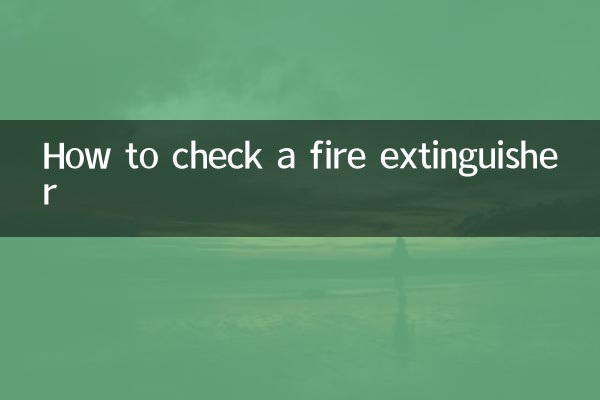Title: How to check a fire extinguisher
Fire extinguishers are important safety equipment in daily life. Regularly checking the status of fire extinguishers can ensure that they work properly in emergencies. This article will introduce in detail how to inspect a fire extinguisher and provide structured data to help you quickly grasp the inspection points.
1. The importance of fire extinguisher inspection

Fire extinguishers are critical tools for extinguishing fires in the early stages of a fire, but if they are not inspected or maintained improperly for a long time, they may become ineffective. Regular inspections ensure that the fire extinguisher has normal pressure, looks good, and is ready for use when needed.
2. Fire extinguisher inspection steps
Here are the specific steps to check a fire extinguisher:
| Check items | Check method | Qualification standards |
|---|---|---|
| Appearance inspection | Check the fire extinguisher shell for corrosion, deformation or damage | The shell is in good condition with no serious rust or deformation. |
| Pressure gauge inspection | Check whether the pressure gauge pointer is in the green area | The pointer is in the green zone (normal pressure) |
| Safety pins and seals | Check whether the safety pin is intact and the lead seal has not been damaged | The safety pin is intact and the lead seal is not removed |
| Nozzles and hoses | Check whether the nozzle is clogged and the hose is cracked | The nozzle is clear and the hose is not damaged |
| Production date and expiry date | Check the production date and expiry date on the fire extinguisher label | Validity period has not expired (usually 10 years) |
3. Fire extinguisher maintenance cycle
The frequency of inspection of fire extinguishers should depend on the environment in which they are used and the type of fire extinguisher. The following are common maintenance cycle recommendations:
| Fire extinguisher type | Check frequency | Remarks |
|---|---|---|
| Dry powder fire extinguisher | once a month | Suitable for home and office |
| carbon dioxide fire extinguisher | Quarterly | Suitable for electrical equipment |
| water based fire extinguisher | once a month | Suitable for ordinary fires |
4. Common problems with fire extinguishers and how to deal with them
When inspecting a fire extinguisher, you may encounter the following questions:
| question | Possible reasons | Treatment method |
|---|---|---|
| The pressure gauge pointer is not in the green zone | Insufficient or too high pressure | Contact a professional to refill or replace |
| Housing rusted or damaged | Not maintained for a long time or the environment is humid | Replace fire extinguisher |
| Nozzle clogged | Blocked by dust or foreign matter | Clean nozzle or replace |
5. Precautions for storing fire extinguishers
The storage environment of fire extinguishers has an important impact on their performance and service life. The following are precautions for storing fire extinguishers:
1.Avoid high temperature and humid environments: Fire extinguishers should be stored in a dry, ventilated place, away from direct sunlight and high temperature sources.
2.Easy to access: Fire extinguishers should be placed in a conspicuous and easily accessible location to avoid being blocked by debris.
3.Regular inspection: Even if the fire extinguisher is not in use, its status should be checked regularly.
6. Summary
Inspection of fire extinguishers is an important part of ensuring safety. By regularly checking the appearance, pressure gauge, safety pin and other key parts, you can ensure that the fire extinguisher can be used normally in emergency situations. At the same time, paying attention to the storage environment and maintenance cycle of fire extinguishers can extend their service life and improve safety.
I hope this article can help you better understand and inspect fire extinguishers, adding a layer of safety and security to your home or work environment.

check the details

check the details